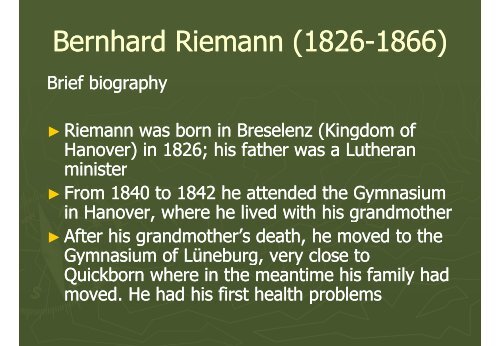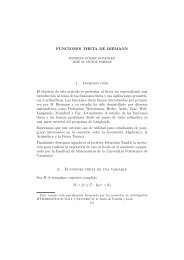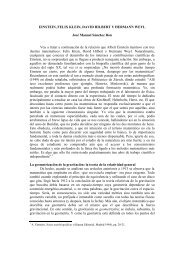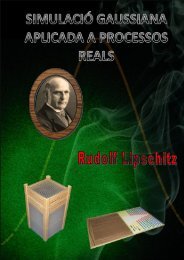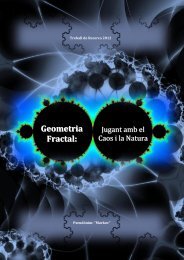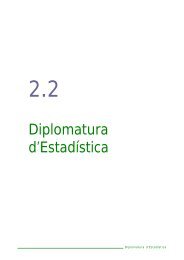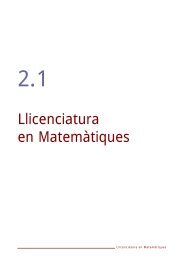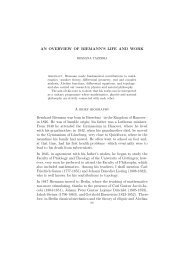Bernhard Riemann (1826 Bernhard Riemann (1826-1866) Bernhard ...
Bernhard Riemann (1826 Bernhard Riemann (1826-1866) Bernhard ...
Bernhard Riemann (1826 Bernhard Riemann (1826-1866) Bernhard ...
You also want an ePaper? Increase the reach of your titles
YUMPU automatically turns print PDFs into web optimized ePapers that Google loves.
<strong>Bernhard</strong> <strong>Bernhard</strong> <strong>Riemann</strong> (<strong>1826</strong> (<strong>1826</strong>-<strong>1866</strong>)<br />
(<strong>1826</strong> (<strong>1826</strong>-<strong>1866</strong>) <strong>1866</strong>)<br />
Brief biography<br />
► <strong>Riemann</strong> was was born born in in Breselenz Breselenz (Kingdom (Kingdom of<br />
of<br />
Hanover) in <strong>1826</strong>; his father was a Lutheran<br />
minister<br />
► From 1840 to 1842 he attended the Gymnasium<br />
in in Hanover, Hanover, where where he lived with his grandmother<br />
► After his grandmother’s death, he moved to the<br />
Gymnasium of of LLüneburg,<br />
LLüneburg,<br />
üneburg, very very close close to<br />
Quickborn where in the meantime his family had<br />
moved. He had his first health problems p
► In 1846 he began to study at the University of<br />
Göttingen öttingen at the Faculty Faculty of of Philology and<br />
Theology. Very soon he moved to the Faculty of<br />
Philosophy, which also included mathematics.<br />
G Gauss was among hi his teachers t h<br />
► In 1847 he moved to Berlin, where he knew<br />
Jacobi Jacobi, Dirichlet, Dirichlet Steiner and Eisenstein Eisenstein, who<br />
deeply influenced his future research<br />
► In 1848 1848 there was a democratic uprising in<br />
Berlin. <strong>Riemann</strong> was among the conservatory<br />
students who opposed it<br />
► In 1849 he went back to the University of<br />
Göttingen öttingen in agreement with his father’s hopes.<br />
He began to attend the seminar of Gauss and<br />
Weber on mathematical physics
► In 1851: Inauguraldissertation g (on ( complex p analysis) y )<br />
► In 1853: Habilitationsschrift (on real analysis)<br />
(pub.1868)<br />
► In 1854: 1854: Habilitationsvortrag Habilitationsvortrag (on (on differential differential geometry)<br />
geometry)<br />
(publ. 1868)<br />
► In 1855 Gauss died; Dirichlet moved to the Univ. of<br />
Göttingen ttingen<br />
► In 1857 <strong>Riemann</strong> was appointed extraordinary prof. at<br />
the the Univ. of of GGöttingen;<br />
GGöttingen;<br />
öttingen; he he published published his his celebrated<br />
celebrated<br />
paper on the theory of Abelian functions<br />
► In 1859 he visited Paris where he knew Bertrand, Biot,<br />
Bouquet Bouquet, Hermite, Hermite Puiseaux and Serret. Serret He was<br />
appointed ordinary professor at the Univ. of GGöttingen.<br />
ttingen.<br />
He published his famous paper on number theory<br />
► I In 1862 he h married i d Elise Eli Koch K h<br />
► From 1863 to 1865 he was in Pisa with Enrico Betti<br />
► In <strong>1866</strong> <strong>1866</strong> he he went went to to Italy again; he he died died on on July July 20 20 in<br />
in<br />
Selasca
Great influence of <strong>Riemann</strong>’s work<br />
► Complex theory of functions (<strong>Riemann</strong> surfaces,<br />
C CCauchy Cauchy-<strong>Riemann</strong> h Ri <strong>Riemann</strong> conditions…) diti )<br />
► Real analysis (<strong>Riemann</strong> integral,<br />
counterexamples,…)<br />
► Topology p gy (connection, ( , “Querschnitte”,…)<br />
Q , )<br />
► Differential geometry (<strong>Riemann</strong>ian manifold,<br />
<strong>Riemann</strong>ian <strong>Riemann</strong>ian curvature curvature tensor)<br />
tensor)<br />
► Number theory (<strong>Riemann</strong>’s conjecture)<br />
► PDE<br />
► Theory of algebraic curves<br />
► Theory of Abelian functions
Main aims:<br />
1. To show some connections among<br />
<strong>Riemann</strong>’s e a s works o s in mathematics at e atcs a and d<br />
also physics<br />
2. To show that his “philosophical” papers –<br />
written itt about b t 1853 and d where h <strong>Riemann</strong> Ri<br />
explained his model of the ether as well<br />
as hi his Naturphilosophie NNNaturphilosophie tt hil hil hi hi – can h help l to t<br />
give a wider and deeper understanding<br />
of fhi his works k in i mathematics th ti and di in<br />
physics
1851 1851 Inauguraldissertation<br />
Inauguraldissertation<br />
1. “Cauchy y –<strong>Riemann</strong> <strong>Riemann</strong> conditions”: <strong>Riemann</strong> considered a complex p<br />
function w=u+iv of a variable z=x+iy such that<br />
∂u<br />
∂x<br />
=<br />
∂v<br />
,<br />
∂y<br />
∂u<br />
∂y<br />
∂v<br />
= −<br />
∂x<br />
(which is nowadays called a “holomorphic function”.)<br />
From this equations he found that ∆u=0, ∆v=0, which are basic<br />
for investigating g g the pproperties p of u and v.<br />
Remark<br />
<strong>Riemann</strong>’s <strong>Riemann</strong> s complex function theory is connected with potential<br />
theory in two dimensions – a theory which <strong>Riemann</strong> knew very<br />
well. In fact, he had followed Weber’s lectures in 1849 and the<br />
following year he partecipated in the physics seminar led by Weber<br />
himself and Gauss.
2. The Dirichlet problem<br />
Both Gauss and Dirichlet – who were <strong>Riemann</strong>’s<br />
teachers in GGöttingen<br />
ttingen and Berlin – studied the so-<br />
called “Dirichlet “Di ichlet problem”: p oblem”<br />
“To find a function u with continuous first partial<br />
derivatives on a given bounded domain, domain which<br />
which<br />
satisfies the Laplace equation ( (∆u=0) u=0) within the<br />
domain domain and and has has given given values values on on the the boundary boundary”<br />
Gauss was led to the Dirichlet problem by<br />
studying the the distribution distribution of of masses masses or or electric<br />
electric<br />
charges on a closed surface S, assuming the<br />
potential potential constant on S.<br />
S.<br />
Dirichlet published an important book on potential<br />
theory in in 1876 1876 (Vorlesungen (Vorlesungen ueber ueber die die im<br />
im<br />
umgekehrten Verhältnisse des Quadrats der der…). …).
3. Conformal mapping:<br />
the <strong>Riemann</strong> Theorem<br />
“Two plane and simply connected surfaces S and<br />
S’ S can be be transformed transformed conformally conformally one into the<br />
other (by a continuous and bijective mapping).”<br />
<strong>Riemann</strong> <strong>Riemann</strong> remarked that that the the assumption assumption “simply simply<br />
connected” surfaces can be removed; then, the<br />
<strong>Riemann</strong> theory theory is is valid valid also also for for <strong>Riemann</strong>ian<br />
<strong>Riemann</strong>ian<br />
surfaces.<br />
Remark<br />
<strong>Riemann</strong> proved his theorem by solving a special<br />
Dirichlet c et p problem. obe
4. The “<strong>Riemann</strong> surface” was introduced by<br />
<strong>Riemann</strong> in in order order to to study study multi multi-valued valued functions<br />
– such as algebraic functions and their integrals.<br />
The <strong>Riemann</strong> surface associated to a function is<br />
composed of as many sheets as are the<br />
branches of the function, connected in a<br />
particular way – so that continuity is preserved<br />
and a single single-valued valued function on the surface is<br />
obtained obtained.<br />
Therefore, he gave an abstract conception of<br />
the space space of of complex complex variables by using a<br />
a<br />
geometrical formulation. In addition, an<br />
algebraic function function has has now now a a geometrical<br />
geometrical<br />
meaning, being interpreted as a <strong>Riemann</strong><br />
surface.
5. “Querschnitte”: <strong>Riemann</strong> made the surface<br />
simply connected connected with with suitable suitable transversal transversal cuts<br />
cuts<br />
and studied the behaviour of the function in the<br />
neighbourhood of of the the singularities.<br />
singularities<br />
Remark<br />
The idea of transversal cut on a surface struck<br />
<strong>Riemann</strong> after a long discussion with Gauss on a<br />
mathematical<br />
mathematical-physical mathematical physical problem problem (letter (letter by<br />
by<br />
<strong>Riemann</strong> to Betti). The origin of the ideas of<br />
<strong>Riemann</strong> surfaces and Querschnitte Q<br />
can be<br />
found in his note on a problem of electrostatic or<br />
thermical equilibrium on the surface of a cylinder<br />
with ih transversal l cuts (“Gleichgewicht (“Gl i h i h der d<br />
Electricitaet ….”, 1876). Here, he was led to<br />
consider a a Dirichlet Dirichlet problem problem on on a a simply<br />
simply<br />
connected and simple sheeted surface.
Remark<br />
1. Complex analysis analysis and and mathematical<br />
mathematical<br />
physics (potential theory) are strictly<br />
connected<br />
2. Connections with PDE. In fact, the<br />
Laplace equation equation represents represents a PDE of the<br />
elliptic kind. Green (1828) showed that it<br />
can be solved by using the the so so-called so called<br />
Green function. Unfortunately the<br />
solution can can be be explicitly explicitly deduced deduced only<br />
only<br />
for special cases.
Generalizations of the Green function<br />
Many mathematicians of the 19th century – such as<br />
Helmholtz Helmholtz, Lipschitz Lipschitz, Betti Betti, Carl and Franz Neumann Neumann, and<br />
<strong>Riemann</strong> himself – deduced functions similar to Green’s<br />
ffunction ti in i order d tto solve l problems bl iin acoustics, ti<br />
electrodynamics, magnetism, theory of heat, and elasticity.<br />
I In a paper (“Ueber (“U b di die FFortpflanzung t fl ebener b LLuftwelle ft ll von<br />
endlicher Schwingungsweite”) published in 1860, <strong>Riemann</strong><br />
applied li d the h method h d of f G Green’s ’ ffunction i iin order d to iintegrate<br />
the differential equation of hyperbolic type describing the<br />
diffusion of acoustic waves. He introduced a function, which<br />
plays the same role as Green’s function did for the Laplace<br />
equation and is today called “Green’s function for the<br />
hyperbolic problem”.
Naturphilosophie p p and the local local-global global g approach pp<br />
In an undated note, written after the completion of his<br />
Inauguraldissertation Inauguraldissertation, <strong>Riemann</strong> wrote wrote that his “main main work work”<br />
involved “a new interpretation of the known laws of nature –<br />
whereby the use of experimental data concerning the<br />
interaction between heat, light, magnetism, and electricity<br />
would make make possible possible an an investigation investigation of of their their interrelationships.<br />
interrelationships<br />
I was led to this primarily through the study of the works of<br />
Newton Newton, Newton Euler and and, on the the other side side, Herbart” Herbart (publ (publ. 1876). 1876)<br />
Remark<br />
Herbart’s psychology inspired both <strong>Riemann</strong>’s model of the<br />
ether (the elastic fluid filling all the universe) and his principles<br />
of Naturphilosophie.
Herbart:<br />
The “psychic act” (or “representation”) is an act of self-<br />
preservation p with which the “ego” g opposed pp the<br />
perturbations coming from the external world. A<br />
continuous flow of representations went from the ego to<br />
the conscious and back. back Herbart studied the connections<br />
between different representations in mechanical terms<br />
as compositions of forces.<br />
Remark<br />
<strong>Riemann</strong> followed Herbart’s psychology in a paper<br />
d drafted ft d i in March M h 1853 1853 (“Neue (“N mathematische th ti h Principien P i i i<br />
der Naturphilosophie”) and in other notes on<br />
Naturphilosophie p p which he intended to publish p (letter ( to<br />
the brother Wilhelm in December 1853) (all of them<br />
publ. in 1876).
<strong>Riemann</strong> <strong>Riemann</strong>, Neue Neue math. math Prinzipien Prinzipien der Naturph Naturph.<br />
► The universe is filled with a substance ( (Stoff Stoff) ) flowing<br />
continually through atoms and there disappearing from the<br />
material world (<br />
(KKörperwelt<br />
(KKörperwelt örperwelt) örperwelt). ) ). From From this this obscure<br />
obscure<br />
assumption, <strong>Riemann</strong> tried to build a mathematical model<br />
of the space p surrounding g two interacting g particles p of<br />
substance: if a single particle of substance is concentrated<br />
at the point point O at time t and at the point O’ at time t’, then<br />
h he considered d d the h two homogeneous h forms: f<br />
2 2 2 2 2 2 2<br />
ds = dx + dx + dx , ds'<br />
= dx'<br />
+ dx'<br />
+ dx'<br />
1<br />
2<br />
3<br />
1<br />
where ( x 1<br />
, x 2 , x 3 ) and ( x'<br />
1 , x'<br />
2 , x'<br />
3 ) are the coordinates<br />
of O and O'.<br />
2<br />
2<br />
3
► <strong>Riemann</strong> considered an appropriate new basis and<br />
compared the two forms associated to the “particle of<br />
substance” b ” at times t and d t’. ’ The h difference dff between b the h<br />
two forms is given by<br />
2 2 2 2 2 2 2<br />
δ ( ds) = ds'<br />
−ds<br />
= ( G −1)<br />
ds + ( G −1)<br />
ds + ( G −1)<br />
ds<br />
where<br />
ds<br />
1<br />
, ds<br />
2<br />
, ds<br />
3<br />
is<br />
1<br />
the<br />
new<br />
1<br />
basis.<br />
His result can be interpreted in terms of the classical<br />
theory y of elasticity. y Since ether is an elastic, , homogeneous g<br />
and isotropic substance, then one can consider an<br />
infinitesimal displacement u and deduce that the difference<br />
δ(ds) depends on the strain tensor due to the<br />
displacement. <strong>Riemann</strong> supposed that this variation δ(ds)<br />
produced a force able to modify the particle in such a way<br />
that the same particle, by opposing this deformation, would<br />
propagate p p g the pphysical y forces through g space. p<br />
2<br />
2<br />
3<br />
2<br />
3
►If If δ(ds)=0, (ds)=0, that is to say that the particle<br />
d does not t change h its it form f f from th the ti time t<br />
to the time t’, then the particle does not<br />
propagate any force since space is not<br />
submitted to deformation by a force.<br />
►On On the contrary, if δ(ds) (ds) is different from<br />
zero, a physical h i l phenomenon h is i<br />
propagated through space.<br />
►<strong>Riemann</strong> <strong>Riemann</strong> tried to connect this formula with<br />
the different different forces forces, such as with gravity gravity,<br />
and with heat and light propagation.
<strong>Riemann</strong> could not explicitly show these connections. He<br />
limited himself to state that gravity, and light and heat<br />
propagation ti can be b explained l i d by b assuming i that th t every<br />
particle of the homogeneous substance filling space has<br />
a direct effect only on its neighbourhood and the<br />
mathematical th ti l l law according di to t which hi h this thi happens h is i due d<br />
to:<br />
“1) 1) the the resistance resistance with which a particle opposes a change<br />
of its volume, and<br />
2) The resistance with which a physical line element<br />
opposes a change of length length.<br />
Gravity and electric attraction and repulsion are founded on<br />
the first part; light, heat propagation, electrodynamic<br />
and d magnetic ti attraction tt ti and d repulsion l i on the th second d<br />
part.”<br />
Remark<br />
<strong>Riemann</strong>’s Naturphilosophie<br />
Naturphilosophie is connected both to some of<br />
his physical concepts on electricity and electromagnetism<br />
and to to his his ideas ideas on on differential differential geometry.<br />
geometry
1. Connections to physics<br />
► Kohlrausch’s Kohlrausch s experiment:<br />
in a Leyden jar (the first capacitor) which had<br />
been charged charged, then then discharged discharged and and left left for for some<br />
time, a residual charge appeared.<br />
In September September 1854, 1854 <strong>Riemann</strong> <strong>Riemann</strong> tried tried to to explain<br />
explain<br />
Kohlrausch’s experiment; for this purpose, he<br />
developed a physical explanation of of the<br />
the<br />
electromotive force and of electric propagation<br />
through g a body y on the basis of the model of<br />
ether expressed in his notes on<br />
Naturphilosophie.<br />
aturphilosophie. The paper was addressed to<br />
AAAnn. Ann. der der dd Physik, Physik Ph Ph ik ik, b but t K Kohlrausch hl h – th the editor dit of f<br />
the journal – asked for so many changes that<br />
<strong>Riemann</strong> retracted retracted the paper paper.
<strong>Riemann</strong> proposed a new theory of<br />
electricity by assuming that the electric<br />
currrent was caused by a reaction of the<br />
body opposed opposed to the change of its its own<br />
own<br />
electric state. This reaction is proportional<br />
to the the charge charge density, density and it it decreased decreased or<br />
increased the electric density according as<br />
th the b body d contained t i d positive iti or negative ti<br />
electricity.<br />
Therefore the transmission of electricity<br />
could not be instantaneous but electricity y<br />
moves “against ponderable bodies” with a<br />
certain speed. p
<strong>Riemann</strong>, “Ein Beitrag zur Electrodynamik”, 1858<br />
He developed a new theory of electromagnetism, by assuming<br />
that that electric electric phenomena travel with the velocity of light and<br />
that the differential equations for the electric force are the<br />
same as those valid for light and heat propagation. (Influence<br />
of Gauss and Weber)<br />
<strong>Riemann</strong>, Partielle Partielle Differentialgleichungen Differentialgleichungen und und deren deren<br />
Anwendungen Anwendungen Anwendungen Anwendungen auf auf auf auf physikalische physikalische physikalische physikalische Fragen, Fragen Fragen , 1876 1876 (ed. (ed. by<br />
by<br />
Hattendorff)<br />
He tried to describe the ether surrounding two interacting<br />
electric particles. For this purpose, he assumed that the ether<br />
possesses physical properties which guarantee electric<br />
propagation. He actually deduced a differential equation<br />
expressing the flux of ether in space space, by using classical<br />
Lagrangian mechanics.
2. Connections to differential geometry<br />
<strong>Riemann</strong>, Habilitationsvortrag, 1854<br />
<strong>Riemann</strong> tried to generalize the ideas contained in his<br />
Naturphilosophie: he extended the “local” investigation of<br />
particles particles of ether ether to to the the “global” global analysis of of n-<br />
dimensional spaces.<br />
Remark<br />
If one one considers considers that an ether fills all space, space then a<br />
deformation of space is linked to a force which has to be<br />
propagated. p p g Force and curvature of space p are then<br />
closely connected; it is space which propagates forces by<br />
changing its curvature.
► A deeper analysis on the connection between n-<br />
dimensional manifolds manifolds and their their curvatures curvatures is<br />
also developed in <strong>Riemann</strong>’s 1861 paper<br />
(“Commentatio ( (“Commentatio Commentatio Mathematica… Mathematica ”) ).<br />
► This ideas were shared by many other<br />
mathematicians of the 19th century (see<br />
Beltrami, Lobachevskij, Clifford). Clifford (The<br />
common sense of exact sciences, 1885) asked<br />
the question “whether physicists might not find<br />
it simpler to assume that space is capable of a<br />
varying of curvature, and of a resistance to that<br />
variation…” and that this resistance was the<br />
responsible of the propagation of phenomena.
The idea of being g in a curved space p which, , thanks<br />
to its changes of curvature, transmitted physical<br />
forces was at the basis of many mathematical and<br />
physical reflections reflections during the 19th 19th century century, long<br />
long<br />
before Einstein’s theory of relativity.<br />
This investigations led to deduce equations and<br />
results in a curved space, p , which is mathematically y<br />
represented by a <strong>Riemann</strong>ian manifold. Tensor<br />
calculus is the more natural formalism for doing<br />
this (tensorial (tensorial equations equations do do not not change change under<br />
under<br />
coordinate changes).<br />
It is not by chance that tensor calculus is the<br />
theory y ad hoc in Einstein’s General Theory y of<br />
Relativity.


